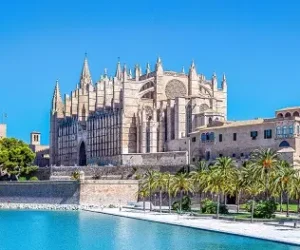The simple answer is yes, tourists are still welcome in Mallorca, but it’s a little more complicated than that. In recent months Mallorca, among other Spanish destinations has been making the headlines with “anti-tourist” demonstrations organised by frustrated locals. Images of Mallorquins carrying banners declaring “Tourists go home” could easily lead you to believe that tourists are no longer welcome and the decrease in holidaymakers the island has experienced this year, would suggest that many people have listened.
But the fact is that Mallorca is not wanting to discourage tourism, they are hoping to reposition their tourist offering to make it more sustainable and more beneficial for the locals.
It’s easy to see why tensions have boiled over. For years, Mallorca has been struggling under the weight of mass tourism. Last year alone, more than 11 million people visited the island — over ten times its population. While tourism makes up around 45% of the island’s economy, the sheer scale has created serious challenges.
Housing prices have soared, partly due to holiday rentals pushing locals out of their communities. Roads are clogged with hire cars in peak season, beaches fill to bursting, and waste management systems are stretched.
For many Mallorquins, life in their own towns and villages feels increasingly unsustainable. The protests are not so much anti-tourist as anti-overcrowding, anti-overtourism. Locals want visitors to appreciate the island in a way that doesn’t harm the very qualities that make it so special.

Rethinking how we visit Mallorca
For generations of British holidaymakers, Mallorca has been the quintessential Mediterranean escape: a short flight away, reliably sunny, blessed with beautiful sandy coves, clear warm sea and lively nightlife in crowded night strips like Magaluf and Arenal.
But tourism officials on the island stress that they are not trying to drive visitors away. Instead, they are encouraging a different type of visitor: those willing to look beyond the mass tourism resorts. They want curious travellers who respect the local culture, spend money in family-run businesses, and explore more of the island’s diverse landscapes.
Is there more to Mallorca than cheap package holidays?
In reality, the mass tourist reputation Mallorca has earned is really limited to the few miles around the coasts. Venture further inland, and not very far at that, and you will find a completely different story.
The Balearic government and local tourist boards are now promoting a model of sustainable tourism. Rather than relying on mass-market resorts, they want to attract travellers who spread their footprint across the island and the calendar year and with an average 300 days of sunshine throughout the year and a wide range of cultural and sporting activities to explore, there really is no reason why this shouldn’t happen.
What does this mean in practice?
The vision that the tourist board is now working to achieve includes encouraging tourists to
- Stay in rural accommodation rather than only in beachside hotels.
- Exploring inland towns and villages, not just the coast.
- Using public transport, cycling, or walking to reduce congestion.
- Dining in local restaurants that serve seasonal Mallorcan cuisine.
- Joining in traditional fiestas and cultural events instead of sticking to all-inclusive entertainment.
- Enjoying hiking, cycling, and nature reserves that show off Mallorca’s wild beauty.
For British visitors, this isn’t a compromise. It’s an opportunity to discover a far richer, more authentic version of Mallorca — one that many tourists have never seen.
Where to Experience Mallorca Differently
So where should travellers go if they want to experience the island the way locals and tourist boards hope they will? Here are a few suggestions ideas.
The Serra de Tramuntana Mountains

Running along the island’s northwest coast, the Serra de Tramuntana is a UNESCO World Heritage Site — and rightly so. Its rugged limestone peaks and terraced valleys dotted with olive and almond groves make it a paradise for walkers and cyclists. Towns like Valldemossa, once home to composer Chopin, and Fornalutx, often dubbed Spain’s prettiest village, are steeped in history.
Sóller and the Vintage Train
The town of Sóller is reached by a charming wooden train that rattles through orange groves and tunnels from Palma. The town itself offers art galleries, bustling squares, and plenty of artisan shops. From here, hiking trails wind up into the mountains or down to the coastal harbour of Port de Sóller.
Binissalem Wine Country
Mallorca’s wine industry is flourishing, and the town of Binissalem is at its heart. Visitors can tour family-run vineyards, sample local wines, and enjoy long, leisurely meals paired with Mallorcan specialities like sobrasada (spicy sausage) and pa amb oli (bread with olive oil, tomato, and cured meats). September’s Festa des Vermar (grape harvest festival) is a lively way to experience rural culture.
Local Fiestas and Traditions

Nearly every town and village on the island has its own fiesta, often featuring parades, fireworks, and traditional dancing. For example, the Fiesta de Sant Antoni in January brings bonfires and music, while the Moors and Christians Festival in Sóller in May re-enacts the town’s history with theatrical flair. Joining these celebrations is a chance to connect with Mallorcans on their own terms.
Natural Parks and Secluded Beaches
While many beaches are overrun in high summer, there are quieter options. Mondragó Natural Park, on the southeast coast, combines sandy coves with bird-filled wetlands and walking trails. The salt flats near Es Trenc offer a glimpse of Mallorca’s natural heritage alongside one of its most stunning stretches of sand.
Palma de Mallorca – the capital
 Palma, the island’s capital, deserves more than a day trip. It is a vibrant city offering a mix of cosmopolitan sophistication and historical charm, boasting a stunning Gothic cathedral, a Moorish palace, vibrant food markets, and a flourishing art scene. Wandering its backstreets reveals boutique shops, tapas bars, and leafy squares where locals gather.
Palma, the island’s capital, deserves more than a day trip. It is a vibrant city offering a mix of cosmopolitan sophistication and historical charm, boasting a stunning Gothic cathedral, a Moorish palace, vibrant food markets, and a flourishing art scene. Wandering its backstreets reveals boutique shops, tapas bars, and leafy squares where locals gather.
How to Travel Responsibly in Mallorca
For British travellers who want to make a positive impact, here are some practical tips:
- Avoid peak season if possible. Spring and autumn are quieter, cooler, and ideal for hiking and cycling.
- Stay local. Family-run fincas (farm stays) and boutique guesthouses spread economic benefits more evenly than large chains.
- Use public transport. Mallorca’s buses and trains are reliable and reach many smaller towns. Cycling is also popular.
- Eat seasonally. Try local markets, traditional bakeries, and restaurants that serve Mallorcan specialities.
- Respect local spaces. Treat villages as communities, not open-air resorts. Dress appropriately, avoid excessive noise, and support local etiquette.
In truth, the protests are not a warning to stay away. They are an invitation to look closer, dig deeper, and discover the Mallorca that lies beyond the tourist clichés. And for those willing to make that shift, the rewards are immense: an island of mountains and vineyards, fiestas and traditions, hidden coves and historic towns.
The Mallorca worth discovering has been there all along — it just asks us to travel differently.
To learn more about independent travel and exploration to Mallorca visit https://visit-spain.info/top-10-things-to-see-and-do-in-palma/
Related articles

Palma de Mallorca off the beaten track
Palma de Mallorca is renowned for its stunning beaches, vibrant nightlife, and historic landmarks like the majestic La Seu Cathedral.

Top 10 things to see and do in Palma
Mallorca features in almost every tourist brochure that covers Spain and in some people’s minds, it is full of lager

10 places to visit on a day trip from Palma
The nice thing about a small island is that pretty much anywhere on the island constitutes a day trip from

A guide to fiestas in Palma and Mallorca
The island’s fiestas are a testament to its rich heritage, blending historical, religious, and folklore elements into celebrations that captivate
